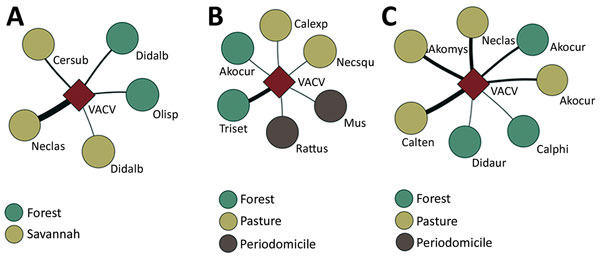Serologic and Molecular Evidence of Vaccinia Virus Circulation among Small Mammals from Different Biomes, Brazil
Júlia B. Miranda, Iara A. Borges, Samantha P.S. Campos, Flávia N. Vieira, Tatiana M.F. de Ázara, Fernanda A. Marques, Galileu B. Costa, Ana Paula M.F. Luis, Jaqueline S. de Oliveira, Paulo César P. Ferreira, Cláudio Antônio Bonjardim, Silvio L.M. da Silva, Álvaro E. Eiras, Jônatas S. Abrahão, Erna G. Kroon, Betânia P. Drumond, Adriano P. Paglia, and Giliane de S. Trindade

Author affiliations: Universidade Federal de Minas Gerais, Belo Horizonte, Brazil (J.B. Miranda, I.A. Borges, S.P.S. Campos, F.N. Vieira, T.M.F de Ázara, F.A. Marques, G.B. Costa, A.P.M.F. Luis, J.S. de Oliveira, P.C.P. Ferreira, C.A. Bonjardim, A.E. Eiras, J.S. Abrahão, E.G. Kroon, B.P. Drumond, A.P. Paglia, G.D.S. Trindade); Instituto Federal de Educação, Ciência e Tecnologia do Sudeste de Minas Gerais, Rio Pomba, Brazil (S.L.M. da Silva)
Main Article
Figure 3

Figure 3. Interaction networks for vaccina virus among small mammals in Sabará (A), Serro (B), and Rio Pomba (C) in Minas Gerais state, Brazil. The square represents vaccinia virus. Circles represent small mammal species (labeled). The color in the circles represents the area where mammals were collected. The thickness of lines increases with the number of positive samples from a species. Acokur, Akodon cursor mouse; Akomys, Akodon cf; mystax; Calexp, Calomys expulsus; Calphi, Caluromys philander; Calten, Calomys tener; Cersub, Cerradomys subflavus; Didalb, Didelphis albiventris; Didaur, Didelphis aurita; Mus, Mus musculus; Neclas, Necromys lasiurus; Necsqui, Nectomys squamipes; Olisp, Oligoryzomys sp.; Rattus, Rattus rattus; Triset, Trinomys setosus; VACV, vaccinia virus.
Main Article
Page created: May 16, 2017
Page updated: May 16, 2017
Page reviewed: May 16, 2017
The conclusions, findings, and opinions expressed by authors contributing to this journal do not necessarily reflect the official position of the U.S. Department of Health and Human Services, the Public Health Service, the Centers for Disease Control and Prevention, or the authors' affiliated institutions. Use of trade names is for identification only and does not imply endorsement by any of the groups named above.
